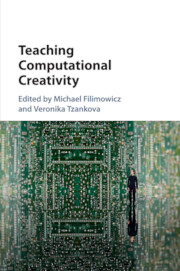Book contents
- Teaching Computational Creativity
- Teaching Computational Creativity
- Copyright page
- Contents
- Figures
- Tables
- Notes on Contributors
- Acknowledgments
- Introduction: Pedagogies at the Intersection of Disciplines
- PART I NEW FOUNDATIONS
- PART II CODE AS MEDIUM
- PART III PHYSICAL{LY} COMPUTING
- PART IV ONLINE LEARNING
- PART V CRITICAL PEDAGOGY
- PART VI TRANSDISCIPLINARY
- 11 From Growing Tools to Designing Organisms: Changing the Literacies of Design
- 12 Pedagogical Experiments in Creative Coding
- Interviews
- Afterword: Toward a Curricular Synthesis
- Index
- References
12 - Pedagogical Experiments in Creative Coding
from PART VI - TRANSDISCIPLINARY
Published online by Cambridge University Press: 04 July 2017
- Teaching Computational Creativity
- Teaching Computational Creativity
- Copyright page
- Contents
- Figures
- Tables
- Notes on Contributors
- Acknowledgments
- Introduction: Pedagogies at the Intersection of Disciplines
- PART I NEW FOUNDATIONS
- PART II CODE AS MEDIUM
- PART III PHYSICAL{LY} COMPUTING
- PART IV ONLINE LEARNING
- PART V CRITICAL PEDAGOGY
- PART VI TRANSDISCIPLINARY
- 11 From Growing Tools to Designing Organisms: Changing the Literacies of Design
- 12 Pedagogical Experiments in Creative Coding
- Interviews
- Afterword: Toward a Curricular Synthesis
- Index
- References
Summary
This chapter aims to contribute new ideas and encourage new approaches to facilitating effective teaching at the intersections of new media arts and computer science. It introduces pedagogical experiments that were developed for a series of “creative coding” courses taught over the last 6 years at public research institutions, and which are currently being used in interdisciplinary classes taught at the Electronic Visualization Laboratory at University of Illinois at Chicago. Each of these courses emphasizes different material, but all are designed to provide students with the technical ability and creative opportunity to think critically about contemporary intersections between technology and culture. Interdisciplinary courses are challenging to teach: students are drawn from different backgrounds and have different interests; they have different technical and creative proficiencies; and they may or may not have experience or enthusiasm for working collaboratively. In addition to providing the motivations for particular pedagogical choices, this chapter discusses specific, pragmatic classroom exercises that have sparked successful research activity and creative exploration.
Information
- Type
- Chapter
- Information
- Teaching Computational Creativity , pp. 273 - 292Publisher: Cambridge University PressPrint publication year: 2017
